
Friday 20 September | 7-8pm | Advanced Research Centre, University of Glasgow, G11 6EW
Free but booking is essential: Please note booking is managed by Doors Open Days.
General GCHT News

Friday 20 September | 7-8pm | Advanced Research Centre, University of Glasgow, G11 6EW
Free but booking is essential: Please note booking is managed by Doors Open Days.
Explore Glasgow’s love-hate relationship with Brutalism through this interactive, multimedia exhibition featuring the work of Glasgow based illustrator Nebo Peklo (Natalie Tweedie).
Journey from Anniesland Tower to the Gallowgate Twins gaining fascinating insights into the city’s Brutalist buildings past and present, with commentary from architects, academics and writers including Miles Glendinning, Diane Watters, Rory Olcayto, Johnny Rodger, Nick Haynes, and Owen Hatherley, as well as first-hand stories from those who lived and worked in these monumental structures.
Devised by Rachel Loughran, a curator specialising in digital design who has previously exhibited with the Alasdair Gray Archive, the exhibition brings Nebo Peklo’s works to life, offering a deeper understanding of this often maligned style of architecture.
Brutal Glasgow tells a uniquely Glasgow story and will make you see Brutalism in a whole new light. Don’t miss out – it might just change your mind about these concrete giants.
Or you can visit in person:
Wednesday to Friday weekly until 25 October 2024
(Closed Friday 27th September due to the public holiday)
Plus weekend opening 26th & 27th October
10am – 4pm
Glasgow City Heritage Trust, 54 Bell Street, Glasgow, G1 1LQ
Free entry
How to get here:
The exhibition space is located in the Merchant City, which has excellent public transport links.
By Bus: More information via First Bus: https://www.firstbus.co.uk/greater-glasgow
By Train: We are around a 15 minute walk from Central Station, a 10 minute walk from Argyle Street Station, and 5 minute walk from High Street Station | More information via Scotrail: https://www.scotrail.co.uk/
By Subway: The exhibition space is located about a 15 minute walk from St Enoch Station | More information via Glasgow Subway https://www.spt.co.uk/travel-with-spt/subway/
In this series we’re delighted to welcome Fay Young onboard as co-host of the episodes which were recorded between March and May 2024.
The first episode was launched on 27 June with an episode released weekly until 29 August.
Tune in to get an exclusive audio tour of Central Station, find out about Glasgow’s Gaelic roots through the study of place-names, and learn about the amazing work of Glasgow photographer Bash Khan.
See below for the episodes & transcripts
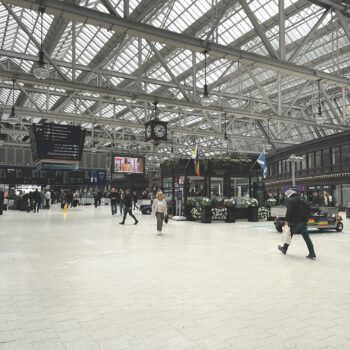
How often do you rush through Glasgow Central Station without a second glance? Never again! Join us on a live, on-location tour with guide Jackie Ogilvie. Discover the station’s fascinating history, hidden architectural details and a behind-the-scenes look at the successful Glasgow Central Station tours. Plus, learn about Jackie’s exciting museum project in the works.
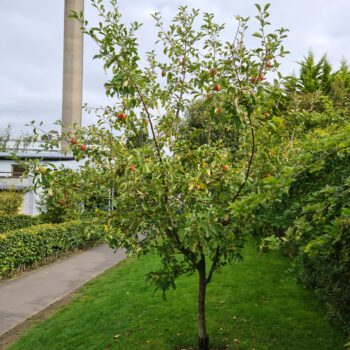
In episode two, Dr Alasdair Whyte, a Gaelic singer, writer, and Research Fellow at the University of Glasgow, joins Fay to explore the medieval Gaelic roots of Glasgow through its place-names.
Alasdair’s research takes us into parts of Glasgow where Gaelic was spoken a thousand years ago. In this green landscape where cattle grazed, we even catch a shadowy glimpse of the farmer’s daughter who owned Shettleston. Yes, Shettleston! When you know where and how to look, place-names are full of human history.
In this conversation Alasdair draws on the evidence in his recently published book Glasgow’s Gaelic Place-names, co-authored with Katherine Forsyth and Simon Taylor. It caused quite a stir and we are about to find out why.
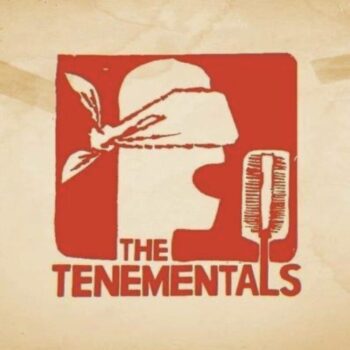
In this episode David, a Professor of Film & TV at the University of Glasgow, discusses with Niall and Fay the innovative project which aims to make and tell history through music rather than traditional academic means. The conversation explores how the band, composed of academics, artists, musicians, and filmmakers, challenges conventional historical narratives.


In today’s episode, Fay introduces Layla Sadr Hashemi and Ume Chauhdry, who share their experiences with the project Thistles and Dandelions, designed to connect ethnic minority women with Glasgow’s cultural heritage. This initiative by Empower Women for Change has been transformative, fostering a sense of belonging among participants.
Layla, originally from Iran, and Ume, from Pakistan, discuss their initial struggles with isolation, language barriers, and cultural differences upon arriving in Glasgow. Discovering EWfC provided them a supportive community and opportunities for personal and professional growth through workshops and training.
Thistles and Dandelions, one of EWfC’s significant projects, ran throughout 2023, engaging women with Glasgow’s heritage beyond just observation. Layla and Ume also describe their involvement with the David Livingstone Birthplace, learning skills in curating, conservation, and exhibition planning, which enhanced their confidence and sense of community.
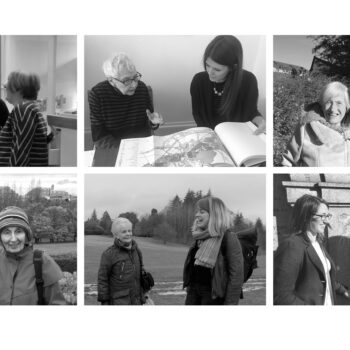
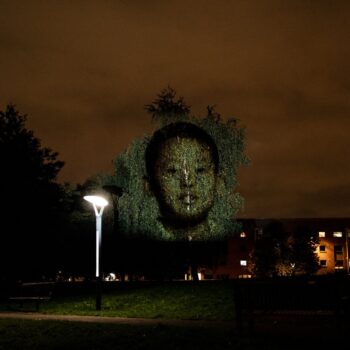
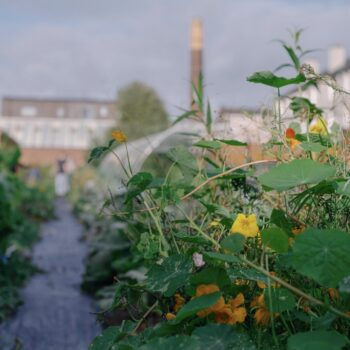
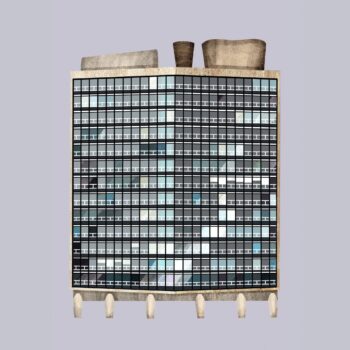
This week we explore Glasgow’s love-hate relationship with brutalism and discuss our upcoming Brutal Glasgow exhibition with digital curator Rachel Loughran and Glasgow based illustrator Nebo Peklo (Natalie Tweedie), who’s work will be displayed in the interactive, multimedia exhibition.
The idea for the exhibition arose from Rachel’s admiration of Natalie’s drawings on Twitter, and united by their shared interest in brutalism they have come together to create Brutal Glasgow. They also discuss the significance of brutalism in Glasgow, touching on its artistic, social, and political aspects, and the debate over whether to demolish or restore such buildings
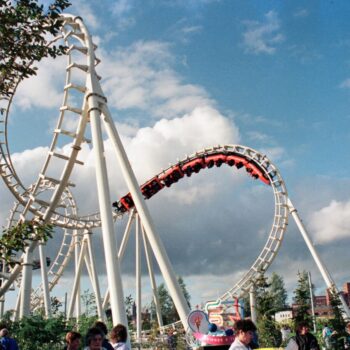
Urban Prehistorian Kenny Brophy, Project Leader Lex Lamb, and Holder of the Official Garden Festival Umbrella Gordon Barr for a conversation with Niall & Fay in front of a live audience, to learn how they have used crowdsourcing to build an ever-growing digital record of the hundreds of pavilions, sculptures and attractions that made up the Garden Festival, as well as the experiences of those who made it happen.
Items with Garden Festival stories to tell were discovered across the UK and further afield, from the large (the Coca-cola Roller Coaster, now in Suffolk) to the small (a Garden Festival tea-towel, now in Papua New Guinea). But in addition to relic artefacts and traces in the landscape, the team identified something else: the absence of a proper record of this pivotal event, while memories fade and documents are lost.
If Glasgow’s Walls Could Talk is produced by Inner Ear and kindly supported by Tunnock’s.


Get ready to peek behind the scenes of the podcast sensation, If Glasgow’s Walls Could Talk! Launched in 2021, this podcast has captivated nearly 18,000 listeners across its first two series, and we’re beyond thrilled to announce that Series 3 is just around the corner!
In our exclusive interview with Dougal Perman, Director and co-founder of Inner Ear, producers of If Glasgow’s Walls Could Talk, we uncover the passion and dedication that fuels each episode. Did you know that while hundreds of thousands of podcasts are out there, many struggle to find an audience? Astonishingly, 90% of podcasts don’t get past three episodes, and a jaw-dropping 99% don’t make it to 21 episodes. But If Glasgow’s Walls Could Talk is breaking the mould, having already delivered 21 thrilling episodes we’re now gearing up for another series of 10!
Mark your calendars: Series 3 launches on June 27th, with new episodes dropping every Thursday.
Tune in on our website or wherever you get your podcasts. Don’t miss out on the great stories that bring Glasgow’s vibrant history to life!
Can you tell us a bit about Inner Ear and your involvement with the podcast?
We’ve been creating podcast radio programmes since we launched our underground music internet radio station, Radio Magnetic in 2001. Over the past 23 years we have explored many subjects and told fascinating stories through podcasts. People, places and provenance are of great interest and importance to us so when GCHT approached us we couldn’t resist getting involved.
Inner Ear is the production company that makes the podcast work. We work closely with GCHT and help with the logistical planning, research and briefing of the interviewees and presenters. We take care of the recording, which is a mixture of remote and live in person recordings, with the latter done on location around Glasgow. We then edit the recordings and create the episodes for the podcast series.
My favourite projects are those where we work collaboratively with our client to deliver the project. That is very true of GCHT. All of the team there are passionate about the subject matter, open to trying new ideas and great fun to work with.
How do you think the podcast evolved from its first series to the third?
When Silvia at GCHT approached me in 2020, she had a clear vision about how to bring the concept to life. Anny and I helped develop the idea and worked out the best way to capture the interviews online, including sourcing affordable equipment and assessing the best platform to use for remote recording. We worked closely with Silvia, Taylor and Niall and created ten episodes that we’re all very proud of. The first series was bursting with ideas and landed very well with the audience.
At the end of series two we decide to bring in another presenter to share hosting duties with Niall and add another dimension to the conversation. As a journalist and editor with extensive experience, everyone thought Fay, who took care of background research and scripting in series 2, was a natural choice. She is also my Mum, so of course I thought she’d be great for the role, but I tried not to influence the decision. She was a bit shy at first, but we all encouraged her and I hope you’ll agree that she and Niall have a great dynamic together.

What has been the most challenging part of producing this series?
The remote recordings are probably the most tricky. It’s great when everything works well and the platform we use is very good. But when everyone involved is remote there are many variables to contend with including equipment, computers, and internet connections.
Those challenges are nothing new to us though and we roll with them as best we can. When it comes to live streaming and remote recording, problems arise all the time. As long as you keep calm, keep everyone informed and are methodical about your problem-solving, there’s always a way through.
If you could pick a favourite episode which one would it be and why?
With 30 to choose from over the three seasons so far it’s difficult to pick one. But if I have to, I loved the last episode of series two when Norry Wilson interviewed Niall about his favourite places and the conversations he’d had. It was lively, personal, thought provoking and made me think about Glasgow’s history in a new way, much like the podcast as a whole, I think. Listen here!

Why do you think If Glasgow’s Walls Could Talk is so popular?
Taking another look at buildings and public spaces and thinking about them in a different way is fascinating. The personal perspectives shared with us in the conversations we hear in this podcast prompt us to do that. I think that really resonates with people.
Finally, can you give us a sneak peek into what listeners can expect in the upcoming series?
I loved listening to (and producing) the live recording of After The Garden Festival. Having been to the Festival when I was 11 years old, making the journey from my home town of Edinburgh, I still have fond memories of a big day out. Reflecting on the impact of the Garden Festival on Glasgow and how transformative it was for the city was really moving.

Catch up on the previous two series of the podcast here before the third one launches next week!



Applications are now open for GCHT’s training grants!
These grants are designed to help fund traditional skills training and professional development opportunities, as well as student research into Glasgow’s built heritage.
Through these grants, GCHT hopes to help cultivate a skilled workforce, foster innovation in heritage projects, and contribute to the sustainable stewardship of our built environment for future generations.
Who Can Apply
Applications are open to anyone working or studying within Scotland’s built environment.
Grants are available for any amounts between £100 to £750, and can be used to help fund things such as:
Traditional skills training
Educational courses
Workshops
Seminars
Research projects
Internships
Apprenticeships
Applications will be judged on their long-term impact, relevance to the historic environment and feasibility.
Other requirements
Applicants must be over 18, however, teachers and youth leaders are welcome to apply for funding for projects that involve young people.
Successful applicants will need to submit a short report that explains how the grant funding was spent, learning outcomes and how it contributed to the wider historic environment sector.
How to apply
To apply please fill in this short form, briefly explaining what you hope to use the training grant for and how it relates to the historic built environment.
Please send completed application forms to info@glasgowheritage.org.uk
Applications are accepted on a rolling basis until the end of the 2024-25 financial year. Applicants will be contacted within 21 days of applying.
The City Chambers is one of the most prestigious buildings in Glasgow. It’s a place where famous visitors are welcomed, and where big events such as civic receptions and award ceremonies are held. However, many Glaswegians have never been inside, or are unaware that free public tours take place every day. Our new online learning resource, ‘Our City Chambers’, aimed mainly at primary school aged children, enables them to explore the building in a way that is accessible, engaging and fun, even if they aren’t able to visit in person. Explore the resource here
It features animations of key rooms within the building, including the Banqueting Hall and Council Chambers. It also shows areas that are not always accessible to the public, such as the Councillors’ Corridor, the Lord Provost’s Office and the Portrait Gallery. It covers the architecture, design and social history of the Chambers, identifying the materials and the traditional skills and techniques employed in its construction and decoration. It also demonstrates how the building is still a functioning workplace for the council, and the role it plays in providing key public services to the people of Glasgow.


We worked closely with the design team at SUUM studio to create this resource. We would like to give our heartfelt thanks to them and to the staff at the City Chambers for their support and insights during the project. Children at St Mungo’s Primary School participated in a series of workshops in the development stages of the project, including a visit to the Chambers. Their perspectives on the building and the city of Glasgow were inspiring and joyful, and were instrumental in shaping the final resource.
A free printed resource to accompany the website has also been produced. It is available to pick up from the City Chambers and from GCHT’s office at 54 Bell Street in the Merchant City. A downloadable PDF will also be added here in due course.
We’d love to see some pictures of you visiting the Chambers – you can show them to us on our Twitter, Instagram or Facebook pages – use the hashtag #ourcitychambers


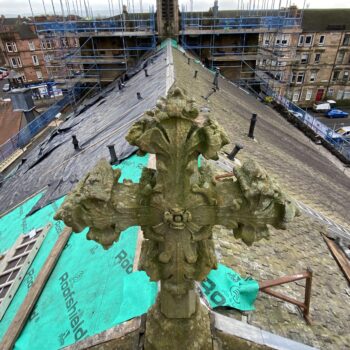
Monday 9th October | 10am – 12 noon | On site at Conservation Masonry, 942-944 South Street, Whiteinch, Glasgow, G14 0AR
This event provides an opportunity to see the craft of stone carving in action, as you’ll see the carving of a new Arts & Crafts influenced stone cross for the apex of the roof at Miller Hall. A Category A-listed historic church in Dennistoun, designed by celebrated architect James Miller, the building was previously known as St Andrew’s East Church and was converted into flats in the early 2000s.
The historic cross is beginning to disintegrate and can’t be left in place due to the risk of pieces of stone falling. It is too important a feature to take away, so the decision was taken to create a replica cut from a new piece of stone.
We will explain the background to the current conservation project, supported by Glasgow City Heritage Trust, and will see the historic stone cross which has been carefully removed from the church. Attendees will learn the various stages of carving involved, from processing a sandstone block, setting out, initial shaping and hand chiselling the stone down to the finished article, including cutting all the exquisite relief detail.
PPE can be provided if necessary, however it would be helpful if attendees could bring their own hard hats, safety eyewear and hi-viz vests/jackets if they can.
All GCHT CPD sessions are recognised by the IHBC, and attendees can obtain a CPD certificate upon completion.
Spaces are limited to 8 people, booking essential.
£10 per person / £5 for students
All sessions are recognised by the Institute of Historic Building Conservation (IHBC) as being capable of contributing to the obligatory CPD requirements of Full Members (see www.ihbc.org.uk)

Thursday 14th September | 7:30 – 8:30pm | The ARC, University of Glasgow, G11 6EW
Join artist Will Knight to hear about the process for creating this incredible new map of Glasgow, as part of the Glasgow Doors Open Days Festival 2023.
Find out about the inspiration for the project as well as the techniques Will used in order to create the final work – tracing and updating Thomas Sulman’s 1864 Bird’s Eye View of Glasgow. Each working drawing is a step towards the final artwork, but the construction of each layer was thought out and planned with a rigorous process for creating each one.
Will studied Architecture at the Glasgow School of Art, and this training has informed his approach to understanding the dynamic relationship between people and place. He has spent the last ten years observing, recording and interpreting Glasgow’s built environment – from the celebrated work of Alexander ‘Greek’ Thomson to the ubiquitous tiled tenement close; from some of the city’s cherished eateries to the scratch bakery and local newsagent. Every subject is explored through measurement and drawn by hand, elevating everyday buildings so that they are revealed afresh.
Free but booking is essential: Please note booking is managed by Doors Open Days and will be available from 1st September, details to follow.

Thursday 14th September | 6 – 7pm | Advanced Research Centre, University of Glasgow, G11 6EW
Free but booking is essential: Please note booking is managed by Doors Open Days and will be available from 1st September, details to follow.

Wednesday 28th June | 7pm – 8pm | Online, via Zoom
Eleven years before Thomas Sulman’s famous bird’s-eye view of Glasgow appeared in the Illustrated London News, a young local artist named George McCulloch produced his own. It gives a vivid glimpse of the industrial city that had sprung up over the past two generations, smeared with smoke and crowded with activity. David Pritchard will describe what he’s been able to find out about the creation of McCulloch’s View, take you on a tour of some of his favourite details and the human stories they hint at, and think a little about the View in relation to other images of Glasgow, from Thomas Sulman to Will Knight.
*
David Pritchard is an adoptive Glaswegian, an occasional mathematician, an enthusiastic but uninformed wanderer of the city’s interesting corners, and a map nerd who spends far too much time in the nineteenth century.
Free, booking essential, donations welcome.
Please note: Payment is taken via PayPal but you do not need to have a PayPal account to pay online.